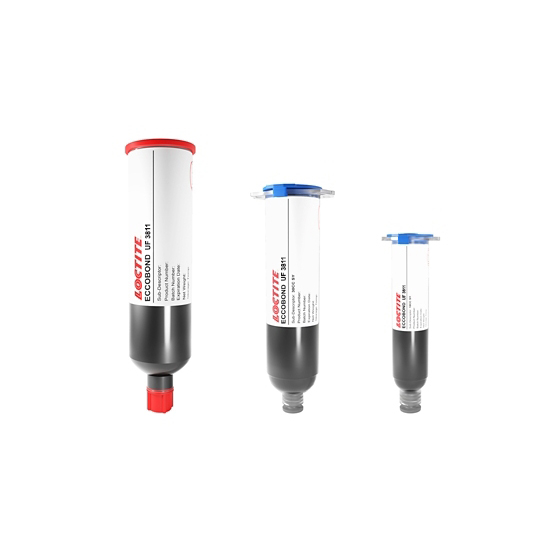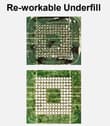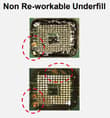LOCTITE ECCOBOND UF 3811
- Reworkable
- Room temperature flow
- Low viscosity
Product Description
LOCTITE® ECCOBOND UF 3811 reworkable epoxy underfill is designed for CSP and BGA applications. This low viscosity material is formulated to flow at room temperature with no additional preheating required. It cures quickly at moderate temperatures to minimize stress to other components. When cured, this material has a high glass transition temperature while maintaining flexibility in order to protect solder joints during thermal cycling and drop testing.
LOCTITE® ECCOBOND UF 3811 has a high Tg while maintaining flexibility in order to protect solder joints during thermal cycling and drop testing. It is a reworkable underfill with good thermal cycling reliability that cures quickly at moderate temperatures to minimize stress to other components.
Cure Schedule
- 60 minutes @ 100°C
- 30 minutes @ 110°C
- 10 minutes @ 130°C
- 7 minutes @ 150°C
Technical Specifications
| General Properties | |||||||
| |||||||
| Pot Life Pot Life Pot life is the amount of time it takes for the viscosity of a material to double (or quadruple for lower viscosity materials) in room temperature after a material is mixed. It is closely related to work life but it is not application dependent, less precise and more of a general indication of how fast a system is going to cure. | 72 hours | ||||||
| Specific Gravity Specific Gravity Specific gravity (SG) is the ratio of the density of a substance to the density of a reference substance; equivalently, it is the ratio of the mass of a substance to the mass of a reference substance for the same given volume. For liquids, the reference substance is almost always water (1), while for gases, it is air (1.18) at room temperature. Specific gravity is unitless. | 1.16 | ||||||
| |||||||
| Physical Properties | |||||||
| Viscosity Viscosity Viscosity is a measurement of a fluid’s resistance to flow. Viscosity is commonly measured in centiPoise (cP). One cP is defined as the viscosity of water and all other viscosities are derived from this base. MPa is another common unit with a 1:1 conversion to cP. A product like honey would have a much higher viscosity -around 10,000 cPs- compared to water. As a result, honey would flow much slower out of a tipped glass than water would. The viscosity of a material can be decreased with an increase in temperature in order to better suit an application | 354 mPa.s | ||||||
| Mechanical Properties | |||||||
| |||||||
| Thermal Properties | |||||||
| |||||||
| Glass Transition Temperature (Tg) Glass Transition Temperature (Tg) The glass transition temperature for organic adhesives is a temperature region where the polymers change from glassy and brittle to soft and rubbery. Increasing the temperature further continues the softening process as the viscosity drops too. Temperatures between the glass transition temperature and below the decomposition point of the adhesive are the best region for bonding. The glass-transition temperature Tg of a material characterizes the range of temperatures over which this glass transition occurs. | 123 °C | ||||||
| Thermal Conductivity Thermal Conductivity Thermal conductivity describes the ability of a material to conduct heat. It is required by power packages in order to dissipate heat and maintain stable electrical performance. Thermal conductivity units are [W/(m K)] in the SI system and [Btu/(hr ft °F)] in the Imperial system. | 0.23 W/m.K | ||||||





